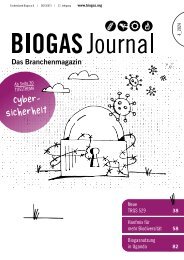You also want an ePaper? Increase the reach of your titles
YUMPU automatically turns print PDFs into web optimized ePapers that Google loves.
Biogas Journal | <strong>Autumn</strong>_<strong>2017</strong> English Issue<br />
The main reasons for these results lie in the features<br />
of this sector, set out at the beginning of this article:<br />
mainly grazing systems with an average of 5 to 6 hours<br />
of confinement per day and excess water in the slurries<br />
(due to washing and rain). This means that the 0.2 m 3<br />
CH 4<br />
/cow/day of biogas and methane (energy) obtained<br />
are insufficient to recover the investment within a reasonable<br />
period.<br />
Another factor that contributes to this low profitability<br />
is that the thermal energy required by dairy farms is<br />
mainly supplied by firewood from the same property,<br />
obtained at a very low cost. On the other hand, bovine<br />
slurries in Chile do not have a large environmental impact<br />
as opposed to other waste, such as those from<br />
the pig industry where implementing biogas offers an<br />
alternative in order to avoid fines or even closure for<br />
non-compliance with the law.<br />
Therefore, finding the key to encouraging the development<br />
of a biogas market for self-consumption in the<br />
Chilean dairy sector is still a challenge. That is why it<br />
is necessary to keep producing public technical and<br />
economic information, as well as moving forward in<br />
training professionals and technicians for the design<br />
and operation of biogas plants. These challenges will be<br />
addressed by the GEF Biogas programme during <strong>2017</strong><br />
and 2018, but it will undoubtedly require a continuous<br />
effort that also includes other agricultural sectors,<br />
encouraging a more efficient use of water and understanding<br />
biogas technology mainly as an affordable and<br />
sustainable option for waste treatment.<br />
In the particular case of Chile, which does not have a<br />
grant policy for developing renewable technologies, it<br />
is key to search for new business models that enable<br />
the farmer to finance these projects, such as the ESCO<br />
model or an associative model. It is also necessary to<br />
look for ways to transform all the non-energy benefits of<br />
a biogas project into financial benefits for the farmer,<br />
such as those derived from a cleaner production, using<br />
digestates for fertilising grasslands and more efficient<br />
use of water, etc.<br />
Authors<br />
Marianela Rosas<br />
Regional Coordinator of the GEF/UNIDO project<br />
Javier Obach<br />
National Coordinator of the GEF/UNIDO project<br />
Christian Malebrán<br />
Chilean Ministry of Energy, Division of renewable energies<br />
Director of the GEF/UNIDO project<br />
45

















